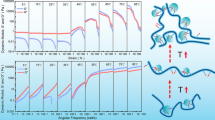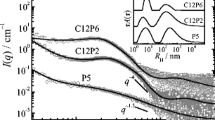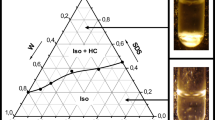Abstract
1H NMR self-diffusion coefficient, spin-lattice relaxation time, spin-spin relaxation time, and two-dimensional nuclear Overhauser enhancement (2D NOESY) measurements have been used to study the association behavior of a novel hydrophobically associating copolymer composed of acrylamide (AM) and a small amount of 2-phenoxyethyl acrylate (POEA), and its interaction with the anionic surfactant sodium dodecyl sulfate (SDS). Three sets of copolymers with approximately the same composition but with different hydrophobic POEA contents were investigated. The POEA contents for these copolymers were about 1.41, 1.03, and 0.56 mol% respectively, as validated by 1H NMR spectra. Self-diffusion coefficient measurements show that the aggregation process occurs in a relative narrow concentration range and the critical association concentrations (cacs), of these copolymers are within this narrow concentration range, which are in agreement with those measured by viscosity measurements (6 g L−1). Above this concentration, the hydrophobic POEA moieties are found to associate and possibly build a transitory three-dimensional network along the polyacrylamide (PAM) backbones, which induces a strong decrease in NMR parameters including self-diffusion coefficients and relaxation times. The surfactant SDS showed a significant interaction with the copolymer in the dilute solution. Addition of SDS resulted in the binding of SDS on copolymer POEA-PAM segments and reinforced the interchain transient network formation of copolymer at a concentration below its cac. In the SDS/POEA-PAM mixed systems, the hydrophobic methylene groups of the SDS molecules were preferentially located in the vicinity of the phenoxy groups of the POEA hydrophobes.






Similar content being viewed by others
References
Noshay A, McGrath JE (1977) Block copolymers. In: Overview and critical survey. Academic, New York
Goodman I (1982) Developments in block copolymers. Applied Science, London
Schulz DN, Kaladas JJ, Maurer JJ, Bock J, Pace SJ, Schulz WW (1987) Polymer 28:2110
Hwang FS, Hogen-Esch TE (1995) Macromolecules 28:3328
Wang TK, Iliopoulos I, Audebert R (1991) In: Shalaby SW, McCormick CL, Butler GB (eds) Water soluble polymers. Synthesis, solution properties and applications, ACS symposium series, vol. 467. American Chemical Society, Washington DC
Malmsten M, Lindman B (1992) Macromolecules 25:5440
Malmsten M, Lindman B (1992) Macromolecules 25:5446
Alexandridis P, Hatton TA (1995) Colloid Surf A 96:1
Zhou Z, Chu BJ (1988) Colloid Interface Sci 126:171
Almgren M, Alsins J, Bahadur P (1991) Langmuir 7:446
Mortensen K, Brown W, Norden B (1992) Phys Rev Lett 68:2340
Brackman JC, Engberts JBFN (1993) Chem Soc Rev 22:85
Pandya K, Lad K, Bahadur PJ (1993) Macromol Sci Pure Appl Chem A 30:1
Hecht E, Hoffmann H (1994) Langmuir 10:86
Hansson P, Lindman B (1996) Curr Opin Colloid Interface Sci 1:604
Volpert E, Selb J, Candau F (1998) Polymer 39:1025
Biggs S, Selb J, Candau F (1992) Langmuir 8:838
Dowling KC, Thomas JK (1990) Macromolecules 23:1059
Bokias G (2001) Polymer 42:3657
Candau F, Biggs S, Hill A, Selb J (1994) Prog Org Coat 24:11
Gao HC, Zhao S, Mao SZ, Yuan HZ, Yu JY, Shen LF, Du YR (2002) J Colloid Interface Sci 249:200
Baskar G, Mandal AB (1995) Langmuir 11:1464
Zhu LY, Dai YH, Li MZ, Wang EJ, Mao SZ, Du YR (2003) Acta Chim Sin 61:671
Dai YH, Wu FP, Li MZ, Wang EJ (2003) Acta Polym Sin 4:525
Wu DH, Chen AD, Johnson JRCS (1995) J Magn Reson A 115:260
Klein J, Conrad KD (1978) Macromol Chem 179:1635
Ernst RR, Bodenhausen G, Wokaun A (1987) Principles of nuclear magnetic resonance in one and two dimensions. Oxford University Press, New York
Stubenrauch C, Nyden M, Findenegg CH, Lindman B (1996) J Phys Chem 100:17028
Acknowledgements
Financial support by the National Key Basic Research Development Program “Fundamental Studies of the Extensively Enhanced Petroleum Recovery” (Project Grant number G1999022503) and the National Natural Science Foundation of China (230373087) are gratefully acknowledged.
Author information
Authors and Affiliations
Corresponding author
Rights and permissions
About this article
Cite this article
Gao, HC., Mao, SZ., Dai, YH. et al. Aggregation behavior of acrylamide/2-phenoxyethyl acrylate and its interaction with sodium dodecyl sulfate in aqueous solution studied by proton 1D and 2D NMR. Colloid Polym Sci 283, 496–503 (2005). https://doi.org/10.1007/s00396-004-1176-2
Received:
Accepted:
Published:
Issue Date:
DOI: https://doi.org/10.1007/s00396-004-1176-2




